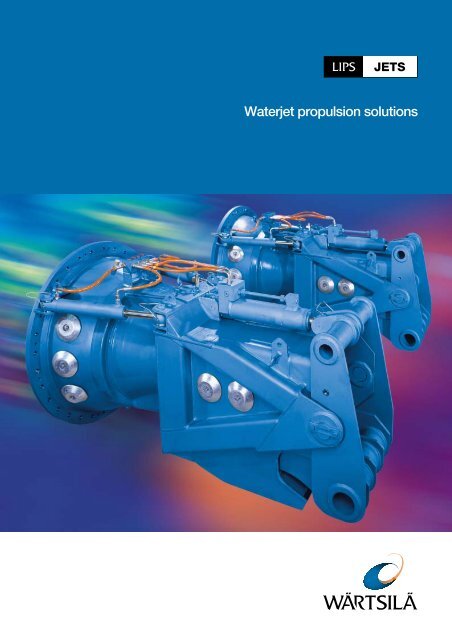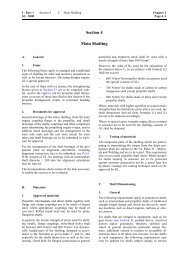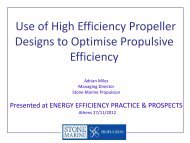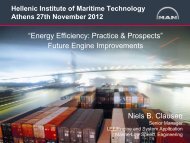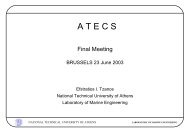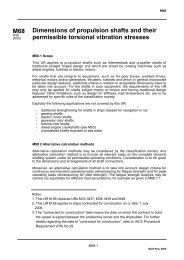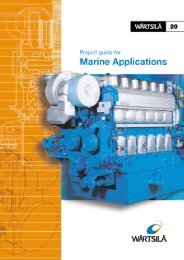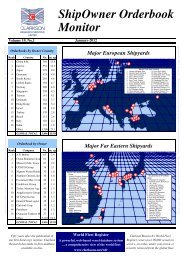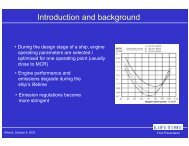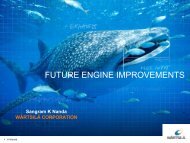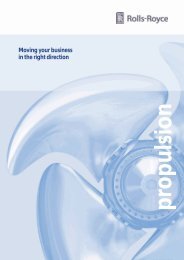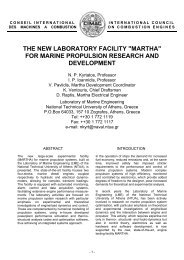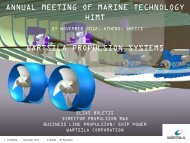Waterjet propulsion solutions - Laboratory of Marine Engineering
Waterjet propulsion solutions - Laboratory of Marine Engineering
Waterjet propulsion solutions - Laboratory of Marine Engineering
Create successful ePaper yourself
Turn your PDF publications into a flip-book with our unique Google optimized e-Paper software.
<strong>Waterjet</strong> <strong>propulsion</strong> <strong>solutions</strong>
Wärtsilä designs waterjet <strong>propulsion</strong> systemsfor the commercial, military and superyachtmarket. A unique welded modular jetconstruction is used that makes it possibleto <strong>of</strong>fer competitive <strong>solutions</strong> in stainlesssteel as well as custom <strong>solutions</strong> in everypower range and in every form andexecution. In close co-operation with alimited number <strong>of</strong> partners, experienced inbuilding welded constructions in stainlesssteel and titanium for the marine and nuclearpower industries, we are developing thefuture <strong>of</strong> waterjet <strong>propulsion</strong>.The waterjet range starts at around 500 kW.Every LIPS ® jet is optimized usingComputational Fluid Dynamics (CFD)calculations based on the design details andoperating pr<strong>of</strong>ile <strong>of</strong> the vessel. The result isthe standard <strong>of</strong> excellence in performanceand reliability that our markets expect.Propulsion <strong>solutions</strong> with waterjets<strong>Waterjet</strong>s <strong>propulsion</strong> is the most successful and efficient method<strong>of</strong> <strong>propulsion</strong> for high-speed applications. The advantages arenot only higher efficiency, but also lower vessel resistance due tothe absence <strong>of</strong> underwater appendages like shafts, rudders andshaftstruts. The absence <strong>of</strong> any parts below the waterline alsomakes waterjets an ideal solution for shallow water operation.The unique design features <strong>of</strong> the Lips jet will ensure access toeven the smallest ports.Hybrid <strong>propulsion</strong> systems - the use <strong>of</strong> two fixed orcontrollable pitch propellers in combination with a centrewaterjet - combine the best <strong>of</strong> both worlds. The propellers areused for normal cruising while the combination <strong>of</strong> the propellerswith the centre waterjet is used to achieve the top speed. Hybridsystems allow optimization <strong>of</strong> the propellers for the normalcruising condition, resulting in improved efficiency, low noiseand vibrations and a smaller propeller diameter.Looking for excellent manoeuvrability at all vessel speeds andfast turn-around times? <strong>Waterjet</strong>s outperform almost every<strong>propulsion</strong> alternative. With catamarans it is usually possible toachieve pure sideways movement and 360 degree turningwithout a bow thruster.Thruster DT-type jet with 360 degree revolving nozzle.2
Feadship with hybrid <strong>propulsion</strong> system.Custom-designed reversible unit for the military market.Designing the solutionWith the largest type and size range <strong>of</strong> waterjets available, wecan <strong>of</strong>fer an optimized configuration for every <strong>propulsion</strong>solution based on the required operating pr<strong>of</strong>ile <strong>of</strong> the subjectvessel. We use Computational Fluid Dynamics to design theoptimum inlet characteristics based on the hull designed by thenaval architect. We can also contribute know-how during tanktests. Several waterjet/stern mounting and installation optionsare available and if required we can take responsibility forcomplete <strong>solutions</strong> with intermediate shaftlines up to thegearbox flange.We aim to be more than just a supplier - we activelyco-operate with all parties involved. The result is a waterjet<strong>propulsion</strong> installation with the lowest possible weight, lowestmaintenance costs, and optimized efficiency and cavitationcharacteristics for all main operating conditions <strong>of</strong> the vessel. Inall cases the solution is competitive with standard <strong>solutions</strong>,especially when considering the true lifecycle costs <strong>of</strong> thecustomized <strong>propulsion</strong> system.On request we can also deliver designs fulfilling very specificdemands for the use <strong>of</strong> advanced materials, special steeringlayouts, control systems, resistance to shock loads or whatevermay be required. Examples <strong>of</strong> our special designs successfully inoperation are a 20 MW jet built according to NATO shockrequirements with a special, high-speed, full power crash-stopinstallation, and a waterjet that supplies thrust in all directionsthrough a 360 degree revolving nozzle.3
Meko A-200 corvette with LJ210E reversible waterjet. The inboard thrust bearing and advanced hydraulic systems put safety andreliability in first place.Key benefits <strong>of</strong> the Lips jetThe design <strong>of</strong> our jets has evolved since the first units weredelivered in the 1970s. The design is unique and focused onreliability and ease <strong>of</strong> maintenance. The main distinguishingtechnical features are listed below.Reliability: the inboard thrust bearingA waterjet thrust bearing can be placed in two positions: on theshaft end outboard <strong>of</strong> the ship in the waterjet stator bowl, orinboard in the engine room. Only one solution makes sense -inboard in the engine room - for three clear reasons: the hostilesea environment is avoided, the risk <strong>of</strong> failure is reduced andmaintenance, if required, is far easier. The inboard thrustbearing, accessible with the ship afloat and without dry-dockingor disassembly <strong>of</strong> the jet stator bowl, minimizes downtime andmaintenance costs. Furthermore, the additional space availableinside the ship makes it easier to install large bearings forincreased lifetime. Every Lips jet has the thrust bearing insidethe ship and operators who have experience with both inboardand outboard thrust bearings praise this unique feature <strong>of</strong> theLips jet.Its advantage is reinforced by the solution we have designedfor the outboard shaft end. The sea environment, unsuitable fora thrust bearing, is ideal for a water-lubricated bearing due tothe high pressure and flow aft <strong>of</strong> the impeller. This makes awater-lubricated bearing a highly reliable, high-tech andlow-cost solution. The tip clearance between the impeller andthe impeller seat ring is accurately tuned by a specially designedinterface between the impeller and the stator bowl, whichbalances the impeller and makes the pump efficiencyindependent <strong>of</strong> bearing wear.Reliability: few moving partsThe design <strong>of</strong> our jets, and especially the design <strong>of</strong> the steeringassembly, is based on the philosophy that the greatest possiblereliability and lowest maintenance requirement is achieved bylimiting the total number <strong>of</strong> moving parts.4
HSV-XI with 4 x LJ150D waterjets.Military vessel operating in hostile waters.OCEA fast patrol boat with 2 x LJ65E waterjets.LJ120E waterjets with inboard hydraulic system.Reliability: inboard hydraulicsAs an option the hydraulic system can even be brought entirelyinside the vessel if required by the operating conditions. Thisremoves all hydraulic hoses and feedback cables from outside thevessel, which increases the system availability.Flexibility: welded jet constructionSince the only cast piece is the impeller, we have almostunlimited flexibility to design the waterjet based on what isrequired. This is demonstrated by the many special designs wehave produced over the years, our customized waterjet/sternmounting options, and the wide range <strong>of</strong> types and sizesavailable. We can <strong>of</strong>fer the exact jet size required with theweight optimized for the engine power and ship speed.Flexibility: Lipstronic/j 7000jet control systemsVarious control system layouts can be realized includingintelligent joystick control systems that integrate the control <strong>of</strong>the waterjet and the bow thruster. As a result, pure sidewaysMain bridge panel <strong>of</strong> the Lipstronic/j 7000 Joystick control system.movement <strong>of</strong> the vessel and 360 degree turning around theship’s axis is possible, enabling fast docking and fastturn-around times. We have optional <strong>solutions</strong> for a number <strong>of</strong>different ship types and operating challenges, such as portablepanels for luxury yachts.5
Rodriquez TMV84 with 4 x LJ91E waterjets.Optimized efficiency: CFD calculationsComputational Fluid Dynamics (CFD) calculationsrevolutionize the hydrodynamic optimization process <strong>of</strong> thewaterjet. With CFD we can optimize every waterjet installationwe supply for the specific design requirements defined by thenaval architect. We have developed a highly advanced CFDmodel <strong>of</strong> our waterjets that is capable <strong>of</strong> analyzing everyoperating condition fast and at low cost. Our CFD model hasbeen validated in hydrodynamic research centres around theworld.Safety: reduced risk <strong>of</strong> cloggingThe Lips jet has only 7 stator blades in the jet bowl after theimpeller compared to 11 or more in other designs - anotherpositive spin-<strong>of</strong>f <strong>of</strong> our inboard thrust bearing. In our design,the "crash-stop" forces acting on the thrust bearing are nottransferred to the stator section <strong>of</strong> the jet, which allows fewerstator blades. The low number <strong>of</strong> stator blades in Lips jetssubstantially reduces the risk <strong>of</strong> cloggingSafety: manoeuvrability,acceleration and crash stop<strong>Waterjet</strong>s <strong>of</strong>fer excellent manoeuvrability from zero to full shipspeed, good acceleration and excellent crash-stop capabilities.Special reversing designs can enhance these features evenfurther.Comfort: low noise and vibrationsNoise and vibrations and hydro-acoustic noise are far lower forwaterjets than for propellers. This improves passenger comfortand reduces the signature <strong>of</strong> a naval vessel.Easy maintenance and serviceKey factors in successful operation include low maintenancecosts and reliable service without downtime and delay due tomechanical problems. To achieve this we have designed our jetsto avoid complex oil-lubricated mechanical components outsidethe vessel and with a philosophy focused on limiting the totalnumber <strong>of</strong> moving parts.To reduce the maintenance costs even further we haveintroduced standard maintenance sets for all main mechanicalmaintenance jobs. To find what is needed to overhaul a6
Rodriquez TMV115 with 4 x LJ114E waterjets.InCat hull 051 with 4 x LJ150D waterjets.InCat hull 050 with 4 x LJ150D waterjets.Austal Autoexpress 86 with 4 x LJ120E waterjets.hydraulic cylinder, for instance, you no longer need to browsethrough parts lists. The maintenance appendix <strong>of</strong> our electronicmanual lists all the necessary parts for the job. Simply print thesheet, add notes as you please and fax it to our <strong>of</strong>fices. Themaintenance set you receive includes all parts and a drawingshowing the replacement. The maintenance sets will reduce yourcosts by saving time during both preparation and overhaul.Furthermore, since the maintenance sets are standardized,logistics costs are reduced on our side and the value <strong>of</strong> the sets isfar higher compared to the individual ordered parts.Example <strong>of</strong> maintenance set for arubber bearing. One maintenanceset includes all the numberedparts, a drawing showing thereplacement, and the consumablesrequired for mounting.7
Townsend Bay <strong>Marine</strong> 21m sportsyacht with 2 x LJ51E.Standard scope <strong>of</strong> supply<strong>Waterjet</strong>s are standard delivered with: Hydraulic powerpacks Load-sensing PTO-driven variable displacement pumps Inboard thrust bearing complete with oil lubrication set Feedback frame for position indication <strong>of</strong> the steeringassembly Bridge control system including engine room control cabinets Design <strong>of</strong> inlet duct hydraulic pr<strong>of</strong>ile.This scope <strong>of</strong> supply can be extended, if required, withintermediate shaftlines in steel or composite materials, shaftcouplings in steel or aluminium, and (partial) waterjet inletducts.<strong>Waterjet</strong> inlet ductThe hydraulic pr<strong>of</strong>ile <strong>of</strong> the waterjet inlet duct is alwaysdesigned by us based on the design and operating parameters <strong>of</strong>the ship. We employ the most modern CFD tools incombination with the deep knowledge we have gained fromcavitation and wind tunnel tests to match the pump and inletduct characteristics. The structural design and construction isnormally made by the shipyard. The inlet duct can then be builtas an integrated part <strong>of</strong> the ship. If required we can also includethe (partial) inlet duct in our scope <strong>of</strong> supply.8
CFD optimisation <strong>of</strong> waterjet <strong>propulsion</strong> system.Hydraulic powerpack and oil lubrication set.Six-bladed impeller and thrust bearing block.LJ65E waterjet.Hydraulic systemThe main components <strong>of</strong> the hydraulic system are the variabledisplacement pump and the powerpack on which theproportional valves and the normal safety and indication devicesare mounted. The proportional valves operate the steering andreversing functions via double pressure lines. The variabledisplacement pump controls the flow so that both functions canbe used simultaneously. A load sensing control system, suppliedas standard with the variable displacement pump, optimizes theefficiency <strong>of</strong> the system by minimizing the heat losses.The variable displacement pump is typically driven by apower take-<strong>of</strong>f on an engine or gearbox. A small separateelectric-driven pump including motor is mounted on thepowerpack for start-up and back-up. A three-way valve enablesthe replacement <strong>of</strong> the filter cartridge in the return line <strong>of</strong> thesystem during operation. The hydraulic system can be suppliedin various executions and with several optional functions.Oil lubrication systemThe oil lubrication system dissipates the heat generated in thebearings and seals <strong>of</strong> the thrust bearing and provides lubrication.The oil is pumped from the reservoir into the pressure linethrough a filter and a cooler.In the thrust bearing housing the flow is divided over theradial and the axial bearings. Since the thrust bearing is insidethe vessel, lubrication under pressure is not required. Anelectric-driven gear or vane pump feeds the oil into the housingfrom where it leaves via natural flow through the return lineback to the reservoir.To minimize losses and weight the thrust bearing housing isonly partly filled. A minimum oil level is maintained at all times,to ensure that the bearings are always running through an oilbath. In the event <strong>of</strong> a power failure onboard the ship the waterjetcan stay in operation at approx. 30% <strong>of</strong> its normal capacity.Systems independent <strong>of</strong> electric power are available as an option.9
Lips jet E-series, 6-bladed waterjetsRelation between power and vessel speed for the most <strong>of</strong>ten used waterjet sizes<strong>Waterjet</strong> selectionThe above graphs indicate the jet size required based on the relationbetween the engine power and the design speed <strong>of</strong> the vessel. Forinstance a ship with four 4000 kW engines and a correspondingdesign speed <strong>of</strong> 35 knots will need four LJ91E jets. A ship with three9000 kW engines and 37 knots will need three LJ135E jets. Thecorrect jet size is thus indicated by the line above the intersection <strong>of</strong>the power and the design speed (see examples in above graphs).The above size range is not complete but represents the most<strong>of</strong>ten-used waterjet sizes up to 50 knots. We are available from theearliest design stages <strong>of</strong> the vessel to work with you on an optimized<strong>propulsion</strong> system. Please contact us for an accurate jet selectionbased on the specific vessel design parameters, or for details <strong>of</strong>waterjets for speeds above 50 knots and 40,000 kW. DXF / DWGformat general arrangement drawings <strong>of</strong> the most <strong>of</strong>ten used sizesare available.10
Lips jet E-series, 6-bladed waterjetsGeneric weights and dimensions for the most <strong>of</strong>ten used waterjet sizesoutboard lengthinboard length<strong>Waterjet</strong>size 1Outboard length[mm] 2Inboard length[mm] 3Transom flange 4Weight steering[kg] 5Weight booster[kg] 5Entrained water[ltr] 6LJ43E 1175 (1260) 1870 725 475 330 250LJ47E 1275 (1370) 2040 795 615 435 330LJ51E 1395 (1490) 2210 860 780 545 420LJ55E 1505 (1620) 2380 930 995 695 530LJ60E 1635 (1760) 2600 1015 1290 910 690LJ65E 1780 (1910) 2810 1100 1635 1155 880LJ71E 1935 (2070) 3070 1200 2070 1465 1150LJ77E 2110 (2250) 3330 1300 2690 1890 1460LJ84E 2290 (2450) 3630 1420 3400 2420 1900LJ91E 2490 (2660) 3940 1535 4470 3160 2410LJ99E 2705 (2890) 4280 1670 5510 3915 3100LJ108E 2945 (3140) 4670 1825 5730 ~ 6860 4085 ~ 4730 4030LJ114E 3100 (3320) 4930 1925 6720 ~ 8100 4755 ~ 5535 4740LJ120E 3270 (3500) 5190 2025 7805 ~ 9635 5605 ~ 6570 5530LJ127E 3465 (3700) 5490 2145 9415 ~ 11170 6625 ~ 7630 6550LJ135E 3685 (3930) 5830 2280 11160 ~ 13160 7925 ~ 9065 7870LJ142E 3880 (4140) 6140 2400 13100 ~ 15390 9395 ~ 10725 9160LJ150E 4095 (4370) 6480 2535 15630 ~ 18560 11195 ~ 12765 10800LJ157E 4285 (4570) 6780 2650 18120 ~ 21170 12985 ~ 14755 12380LJ164E 4475 (4770) 7090 2770 20505 ~ 23815 14715 ~ 16635 14120LJ171E 4665 (4980) 7390 2890 23205 ~ 27815 16745 ~ 19255 16000LJ179E 4880 (5210) 7730 3025 26410 ~ 31605 19320 ~ 21940 18350LJ190E 5185 (5530) 8210 3210 32805 ~ 37240 23671 ~ 26075 21950LJ200E 5460 (5830) 8640 3380 38100 ~ 43870 27900 ~ 30255 25600Notes:1. The waterjets defined in the above table are the most<strong>of</strong>ten used waterjet sizes. Intermediate sizes for the aboverange like a LJ160E or LJ175E size and the data for therange up to the LJ400E size are available on request.2. The data in brackets is the maximum outboard length infull reverse and steering.3. Inboard length may vary depending on the optimizedshape <strong>of</strong> the inlet duct.4. Transom flange connections can be custom designed. Smaller transom flangediameters are possible if the requirements for the interface with the hull are met.5. Weights are calculated based on jet power density. Please contact us for theweights <strong>of</strong> the jet sizes above the LJ99E based on the power density <strong>of</strong> yourdesign. Weights include an inboard bearing, but exclude hydraulic powerpacksand oil lubrication sets.6. Water in the inlet duct is calculated to the transom and based on the standardshaft height.11
W0404/bock´s Office/PrinterWärtsilä is The Ship Power Supplier for builders, owners and operators<strong>of</strong> vessels and <strong>of</strong>fshore installations. We are the only company with aglobal service network to take complete care <strong>of</strong> customers' shipmachinery at every lifecycle stage.Wärtsilä is a leading provider <strong>of</strong> power plants, operation and lifetimecare services in decentralized power generation.The Wärtsilä Group includes Imatra Steel, which specializes in specialengineering steels.For more information visit www.wartsila.comWÄRTSILÄ ® and LIPS ® are registered trademarks. Copyright © 2004 Wärtsilä Corporation.Wärtsilä Propulsion Netherlands B.V.Lipsstraat 52, P.O. Box 6Tel: +31 416 3881155150 BB DrunenFax: +31 416 373162The Netherlandswww.wartsila.com


